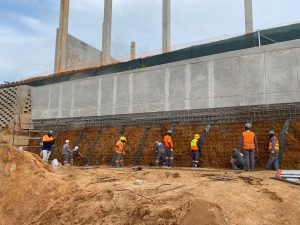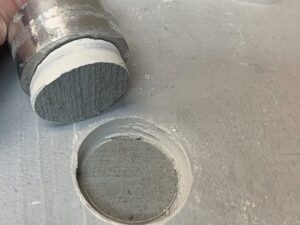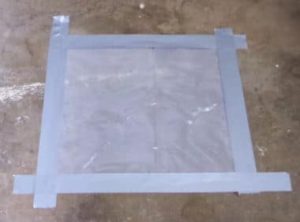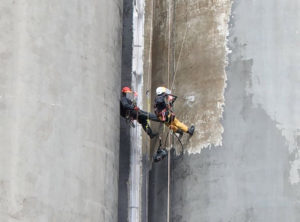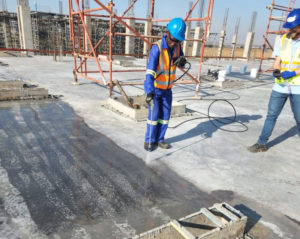By Sheldon White
Colloidal silica post-placement pozzolan technology can be used with any flooring coverings and adhesives that are to be placed over concrete. It does not have a negative effect on the flooring material or adhesion of flooring material.
SCP works within the concrete. It penetrates into the concrete mix blocking the capillaries and pores but does not seal the surface. This means that the mechanical key to which the adhesive bonds is still in place.
However, there is sometimes confusion between colloidal silica post-placement pozzolan technology and silicate penetrating compounds. Colloidal silica is also not a bond breaker. Both “silicate penetrating compounds” and “other foreign materials that might affect the rate of moisture dissipation” and “the adhesion of resilient flooring to the concrete” are prohibited by the ASTM F710 Standard Practice for Preparing Concrete Floors to Receive Resilient Flooring.
Colloidal silica is not silicate-based
Our colloidal silica post-placement pozzolan technology is not a silicate-based product.
Common topically applied silicates consist of Sodium (Na), Potassium (K), or Lithium (Li) chemically bonded to silica (Si). Typical topically applied silicates already have a cation, such as sodium and potassium, that is bound to the silica to form a silicate. The calcium silicate hydrate (C-S-H) that is formed by this silica after it reacts with calcium hydroxides is a shorter chain morphology. It is unstable in nature and, therefore, inferior to Portland cement/water-formed C-S-H. Common topically applied silicates also produce potassium, sodium, or lithium hydroxides as by-products. Conversely, colloidal silica post-placement pozzolan technology produces long chain C-S-H. It is sufficiently more stable than even the “natural” C-S-H formed during the hydration of the cement.
Colloidal silica and amorphous silica
Colloidal silica post-placement pozzolan technology consists of a stable dispersion of nano-sized particles of amorphous silica. These comprise a charged nucleus which is surrounded by an extended diffuse ionic atmosphere. The colloidal state of subdivision consists of particles with a size sufficiently small (≤ 1 μm) so as not to be affected by gravitational forces. However, they are large enough (≥ 1 nm) to show marked deviations from the properties of true solutions. Colloidal silica post-placement pozzolan is one of the best sources of the pozzolanic reaction known to man. Colloidal silica post-placement pozzolan reacts with calcium hydroxide in the pore space to form secondary C-S-H. It reduces the size of capillary voids and pores. This leads to a denser and more homogenous structure and, in doing so, greatly improving the mechanical properties of the concrete.
Colloidal silica is not a bond breaker
Colloidal silica was tested to show that it is not a bond breaker. A bond breaker is a product that forms varying layers of separation between contact surfaces. Colloidal silica post-placement pozzolan technology is a penetrating treatment that does not change the surface of the concrete. An SCP application is not a coating and, therefore, cannot adversely affect bond integrity.
The first test was undertaken according to ASTM C1583 Standard Test Method for Tensile Strength of Concrete Surfaces Bond Strength or Tensile Strength of Concrete Repair and Overlay Materials by Direct Tension (Pull-off Method). The other was undertaken according to ASTM E303 Standard Test Method for Measuring Surface Frictional Properties Using the British Pendulum Tester.
Testing colloidal silica
Testing colloidal silica post-placement pozzolan technology according to the ASTM C1583 test method first entailed removing surface contaminants and loose or deteriorated concrete. This sample was then prepared to typical surface conditions. The test material was applied and cured according to the manufacturer’s specifications. A circular cut was then made perpendicular to the surface. The test material was left intact on the concrete substrate. A steel disk was next attached to the top of the material using an epoxy adhesive. To apply a tensile load to the test sample, a tensile loading device was then attached to the steel disk. The force applied was parallel to the vertical axis of the specimen. Load was applied until failure and the results recorded.
Testing colloidal silica according to ASTM E303 entailed first cleaning the concrete surface to ensure that it was free of loose particles.The instrument was placed and levelled. A pendulum was then lowered so that the edge of the slider just touched the concrete surface. Next, the entire surface of the concrete was wet with water. One swing was performed. This was followed by four more and the surface rewet before each swing. The results were then recorded.
Colloidal silica improves pull strength
Testing showed that colloidal silica post-placement pozzolan technology actually increases the pull-off strength of concrete by up to 73% compared to untreated concrete. It also had no statistical effect on surface friction.
SCP treatments become an integral part of the concrete matrix. Therefore, additional treatments or removal prior to using a covering or coating are also not required. Preparation to the required level of concrete surface profile of the covering or coating manufacturer can be accomplished without it interfering with SCP product performance.


